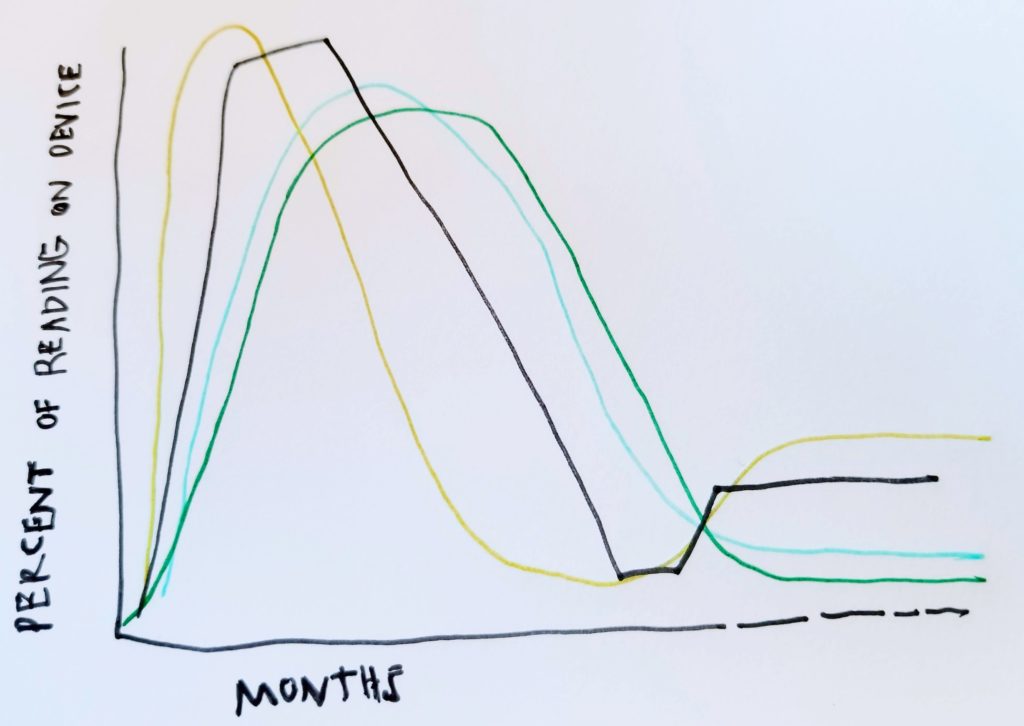Getting back to the text with ebooks
There must be a name in business school for the curve of ebook reading v. real books, for the shape that flares up at the beginning for individual readers, drops way down, possibly to zero, and then gradually climbs back a bit to some lower, steady level, like this:

Every ereader I know experiences some version of this curve. If we do it at all, we fall in love with the novelty of ereading, the cost and time savings, the ease of carrying around a pile of books on one device. The features of the ereader itself, like its bed-time back-lighting. But all or most of that leeches away in the face of this creeping feeling that we’re not actually reading, not actually absorbing the words as we flip through them, not seeing scenes, or having the recommended catharses, not getting into the text.
I’m on the steady, later part of the curve now, reading maybe half of my books and some magazines on a Kindle 1 device. The whiz-bang novelty has worn off, and so I feel like I’m finally in a position to appreciate the genuinely useful features of a digital reading device, the ones that are not pale versions of the book but advantages:
- Searching in an ebook is real. It’s fantastic. The more you do it, the more you use this habit you acquired from web-surfing to locate, say, the first reference to a character, the name of a town.
- e-Ink is really nice now. I tried reading on an Android tablet and the reflective glare and dim screen made that a non-starter outdoors.
- Back-lighting and font control: I’m getting older! It’s nice to read on a device whose illumination, font-size and layout I can control. Keeps me from having to use readers. Plus I can read at night and disturb my wife [less].
- Goodreads.com integration: If you can get over how bummed you are about how big and monopolistic Amazon is with the experience of reading, you can like how your lists on Goodreads.com–to-read, currently reading, etc.–are integrated into the ereader. A related item is that you can share your highlights and notes in the ebook as its own text, and can see sections and passages in a book that have been highlighted a lot.
- Send content to your device to read later.
The feature of Kindles that I was most eager to try is this WhisperSync, which is a bridge between an ebook and its audio version. Amazon, having purchased Audible, allows you to move back and forth between the ebook and audiobook versions seamlessly, reading then listening, then reading. (The audio version is often advertised for this at a cheaper, “buy also” cost.)
For me, the whole point of returning to ebooks after having fallen down the ereading curve above, like everybody else, was not to take the place of actual books but to get a digital reading experience that wasn’t smothered in sidebar ads, cloying, embedded “read also” links, and bad layouts; hidden behind paywalls or hopelessly short or slapdash. I want digital long-form. I send myself readable versions of articles and focus on them as texts.
The ereader is pretty good for this. As you get used to it, it keeps improving, in my opinion.
And when you sync an ebook across the Kindle, the Audible version on your headphones 2, and maybe also the Kindle app on your phone for a quick few pages at the grocery store, it gets….really different, and maybe great! You can read a chapter, then hear the next one read by the author in a voice that’s completely consistent with your own internal one. It gets to be (again) like: I’m going to dive into the book. Too early to tell yet, but maybe syncing between these different formats can be even more absorbing, can reclaim “the text” for what it was before all these devices and distractions started diverting us.
Notes:
- Which reading platform to use—the Kindle, the Nook, or another device, like the Kobo—is another story, and one I want to write about soon, since I used to do pro-indy, anti-Kindle work for bookstores, have owned various Nooks as well, and now use this Kindle. ↩
- You can use Bluetooth or aux headphones in newer Kindles ↩